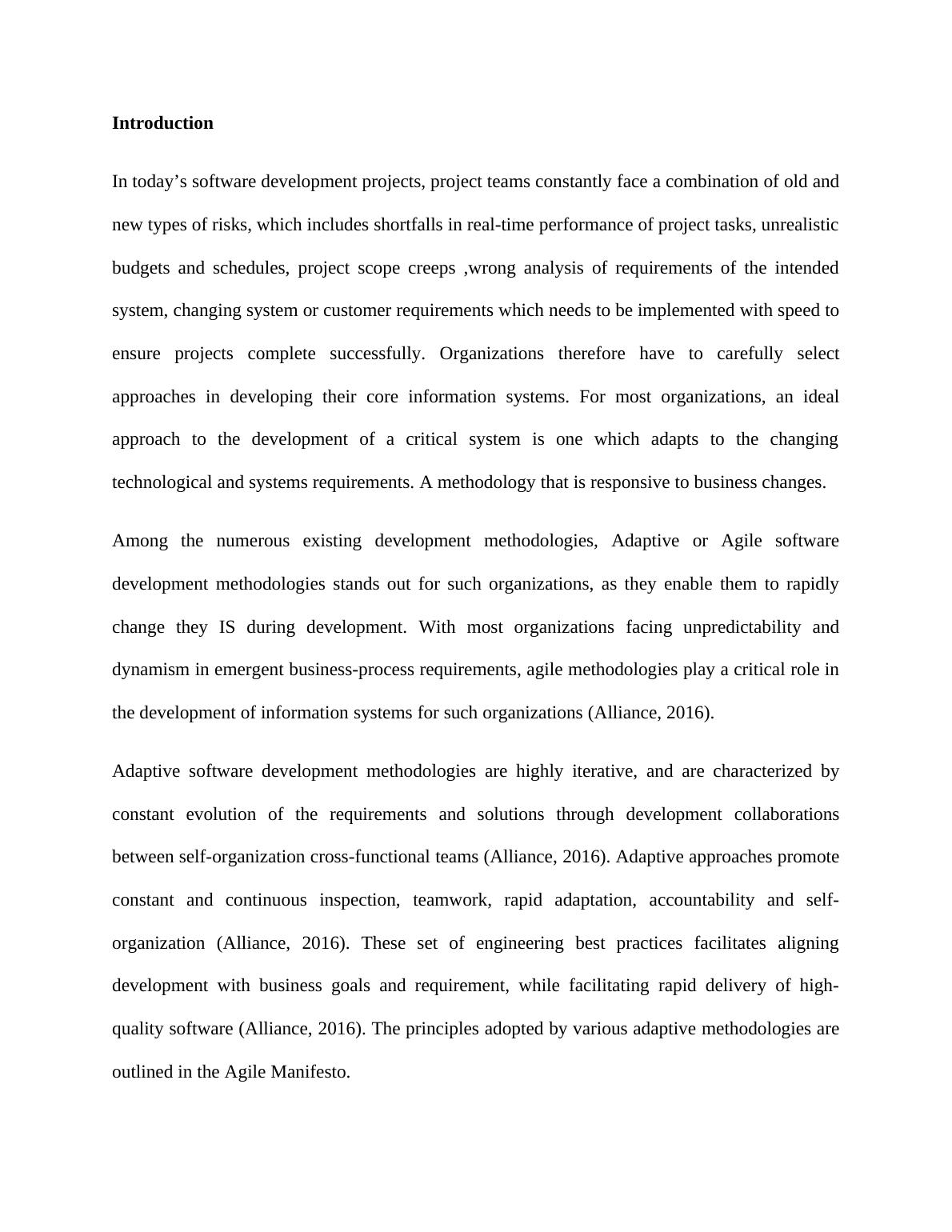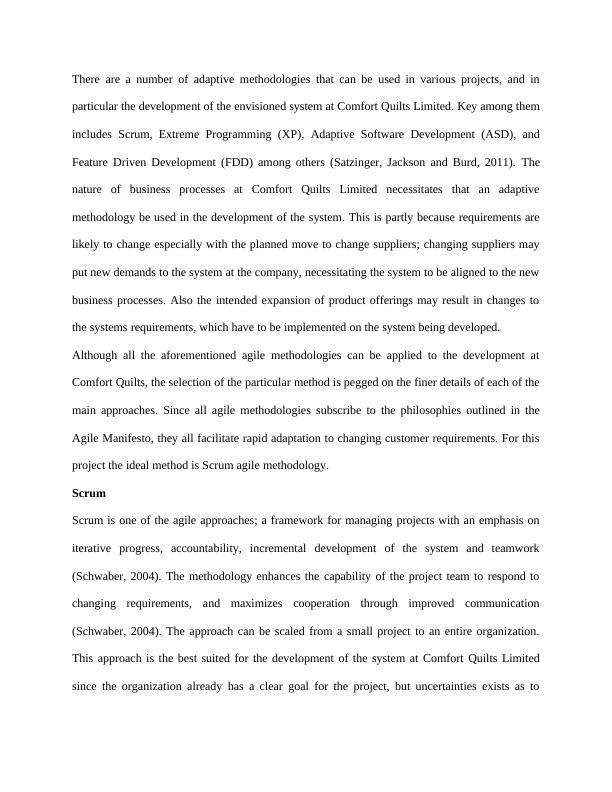System Analysis and Design | Report
Added on 2020-05-11
11 Pages1826 Words72 Views
System Analysis and Design[Name]Course CodeInstitution

IntroductionIn today’s software development projects, project teams constantly face a combination of old andnew types of risks, which includes shortfalls in real-time performance of project tasks, unrealisticbudgets and schedules, project scope creeps ,wrong analysis of requirements of the intendedsystem, changing system or customer requirements which needs to be implemented with speed toensure projects complete successfully. Organizations therefore have to carefully selectapproaches in developing their core information systems. For most organizations, an idealapproach to the development of a critical system is one which adapts to the changingtechnological and systems requirements. A methodology that is responsive to business changes. Among the numerous existing development methodologies, Adaptive or Agile softwaredevelopment methodologies stands out for such organizations, as they enable them to rapidlychange they IS during development. With most organizations facing unpredictability anddynamism in emergent business-process requirements, agile methodologies play a critical role inthe development of information systems for such organizations (Alliance, 2016). Adaptive software development methodologies are highly iterative, and are characterized byconstant evolution of the requirements and solutions through development collaborationsbetween self-organization cross-functional teams (Alliance, 2016). Adaptive approaches promoteconstant and continuous inspection, teamwork, rapid adaptation, accountability and self-organization (Alliance, 2016). These set of engineering best practices facilitates aligningdevelopment with business goals and requirement, while facilitating rapid delivery of high-quality software (Alliance, 2016). The principles adopted by various adaptive methodologies areoutlined in the Agile Manifesto.

There are a number of adaptive methodologies that can be used in various projects, and inparticular the development of the envisioned system at Comfort Quilts Limited. Key among themincludes Scrum, Extreme Programming (XP), Adaptive Software Development (ASD), andFeature Driven Development (FDD) among others (Satzinger, Jackson and Burd, 2011).Thenature of business processes at Comfort Quilts Limited necessitates that an adaptivemethodology be used in the development of the system. This is partly because requirements arelikely to change especially with the planned move to change suppliers; changing suppliers mayput new demands to the system at the company, necessitating the system to be aligned to the newbusiness processes. Also the intended expansion of product offerings may result in changes tothe systems requirements, which have to be implemented on the system being developed.Although all the aforementioned agile methodologies can be applied to the development atComfort Quilts, the selection of the particular method is pegged on the finer details of each of themain approaches. Since all agile methodologies subscribe to the philosophies outlined in theAgile Manifesto, they all facilitate rapid adaptation to changing customer requirements. For thisproject the ideal method is Scrum agile methodology. ScrumScrum is one of the agile approaches; a framework for managing projects with an emphasis oniterative progress, accountability, incremental development of the system and teamwork(Schwaber, 2004). The methodology enhances the capability of the project team to respond tochanging requirements, and maximizes cooperation through improved communication(Schwaber, 2004). The approach can be scaled from a small project to an entire organization.This approach is the best suited for the development of the system at Comfort Quilts Limitedsince the organization already has a clear goal for the project, but uncertainties exists as to

whether the requirements would change, within the project without changing the goal. Such asituation is ideal for scrum development since it ideally require development to start with what isknown, and track progress, tweaking the requirements as need arises to achieve the desired goal.The methodology is founded on three pillars; adaptation, inspection and transparency (Schwaberand Beedle, 2002). A traditional software development approach would not be ideal for the system development atComfort Quilts. Convectional methodologies do not factor in changing requirements in the phaseof project execution. On the contrary, agile approaches such as scrum understand today’scomplex business processes and volatility of the operating environment, which may requirechanges before the final solution is delivered (Kniberg, 2015). The guiding principles outlined inthe Agile Manifesto puts particular emphasis on collaboration, flexibility to adapt emergingbusiness realities , collaboration and autonomy of teams (Schwaber and Beedle, 2002). Where Scrum is taken as the methodology of choice, roles have to be indentified for the mainproject stakeholders. Scrum specifies three main roles in a project, The Product Owner, ScrumMaster and Team. Scrum RolesProduct Owner:The stakeholder with the role of Product Owner has the ultimateauthority over the project. Product Owner holds the project’s vision and shouldtherefore constantly communicate the vision and priorities to the team in charge ofdevelopments (Schwaber and Beedle, 2002). Although Scrum teams are autonomous,the Product Owner has the responsibility of ensuring the vision of the project is beingachieved without micro managing the team (Kniberg, 2015). Product Owner shouldbe available to clarify queries that the project team may have.

End of preview
Want to access all the pages? Upload your documents or become a member.
Related Documents
ICT310 System Analysis and Design - Assignmentlg...
|9
|1322
|149
Adaptive Systems Development Methodology | Assignmentlg...
|15
|3071
|105
Agile and Iterative systems developmentlg...
|13
|2483
|364
Adaptive Systems Development Approach: Assignmentlg...
|13
|1754
|41
Assignment on System Analysis & Designlg...
|12
|1942
|52
Agile and Iterative Methodologies assignmentlg...
|12
|2710
|197
